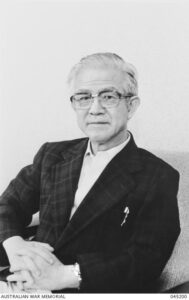

From Nagasaki Survivors: Stories of Endurance and Courage, an essay by Lynne Shivers:
[August 9, 1945, three days after the bombing of Hiroshima, the second atomic bomb fell on Nagasaki.] “…Dr. Tatsuichiro Akizuki was a physician at the First Ukakami Hospital (the present-day St. Francis Hospital) of Nagasaki, located only 1,500 meters from the epicenter [of the atomic explosion]. He remembered that the initial bright flash of light was followed by an enormous blast. The whole hospital collapsed in debris around him and the other workers and patients. He thought the bomb must have hit the hospital directly, a common misperception in both cities. When he got to a room and looked out, this is what he records:
. . . dun-colored smoke or dust cleared little by little. I saw figures running. . . . The sky was as dark as pitch, covered with clouds of smoke; under that darkness, over the earth, hung a yellow-brown fog. . . . All the buildings I could see were on fire: Urakami Church, the largest Catholic church in the east [Asia] was ablaze. Electricity poles were wrapped in flame like so many pieces of kindling. Trees on the near-by hills were smoking, as were the leaves of sweet potatoes in the fields. . . . It seemed as if the earth itself emitted fire and smoke, flames that writhed up and erupted from underground. . . . It seemed like the end of the world.
Dr. Akizuki and other staff helped remove patients and other employees from the burning hospital. Soon, people arrived with various wounds and terrible burns. Staff created sparse meals of rice and pumpkin. A few days later, a civilian patrol demanded that the hospital become a relief center with Dr. Akizuki as the leader. He resisted, saying he was only a doctor, but the patrol leader was adamant. The worst of the pain, confusion, fear, and death lasted to the end of September.1
The story continues in The Book of Miso:
Throughout the following two years… Dr. Akizuki and his staff worked daily in prolonged close contact with fallout victims in areas of Nagasaki which were heavily damaged and highly radioactive. Nevertheless, neither he nor his associates suffered from the usual and expected effects of radiation. Dr. Akizuki was extremely interested in this phenomenon, which he hypothesized may well have been due to the fact that he and his staff had been drinking miso soup regularly. But he felt that only a thorough scientific study of the phenomenon could provide the full answer.
In 1972, a number of Japanese scientists, including Dr. Morishita Keiichi doing agricultural research stimulated by Dr. Akizuki’s writings, discovered that miso contained dipicolinic acid. Produced by miso and natto yeasts, it is an alkaloid which chelates (grabs onto) heavy metals such as radioactive strontium and discharges them from the body.2
“For the rest of his life, Dr. Akizuki was thought of as a heroic figure as he continued his medical work at the hospital. Later he became chairman of the Nagasaki Foundation for the Promotion of Peace.”3


PH: 413.369.4057
Information
Sign up for our newsletter, South River Currents, where we share stories, photos, recipes, videos, and more.